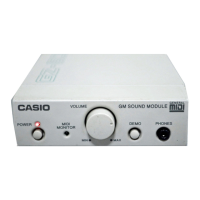
Do you have a question about the Casio GZ-50M and is the answer not in the manual?
| Brand | Casio |
|---|---|
| Model | GZ-50M |
| Category | Recording Equipment |
| Language | English |
Details sound source, digital effects, demonstration tune, volume, MIDI monitor, tuning, and terminals.
Details current drain, maximum volume, phone output, line output, and minimum operating voltage.
Specifies MIDI channel range and note number/velocity handling.
Details program change channel assignments and pitch bend data.
Lists control change numbers for modulation, volume, pan, expression, hold, and effects.
Explains RPN usage for pitch bend, fine tuning, and coarse tuning.
Covers active sensing, channel pressure, and system exclusive effect changes.
Details initial settings for program change, pitch bend, volume, pan, expression, sustain, soft, effect depth, pitch bend sense, coarse/fine tune, RPN, and channel pressure.
Outlines initial settings for drum set number, volume, pan, expression, effect depth, and soft for Channel 10.
Details transmitted and recognized MIDI messages for basic channel and mode.
Specifies MIDI chart for note number, velocity, and after touch.
Covers pitch bender, control change messages, and their parameters.
Details program change, system exclusive, system common, system real time, and aux messages.
Lists piano, bass, and chromatic percussion tones with their GM octave ranges.
Lists string/orchestra and organ tones with their GM octave ranges.
Lists guitar and brass tones with their GM octave ranges.
Lists various tone categories with their GM octave ranges.
Lists percussion and SFX tones with their GM octave ranges.
Maps MIDI note numbers to specific drum instruments and their names.
Shows the overall system architecture and component interconnections.
Details the functions and pin assignments of the CPU.
Explains the DSP's role in sound processing and effect application.
Lists the pin functions for the Digital Signal Processor (LSI103).
Describes the interface between the DSP, Sound Source ROM, and Effect RAM.
Details the functions and pin assignments of the Digital-to-Analog Converter.
Illustrates the block diagram of the DSP and DAC interface.
Lists the pin functions for the Digital-to-Analog Converter (LSI101).
Explains the generation of various voltages by the power supply circuit.
Details the CPU and DSP reset sequence upon power-on or adapter connection.
Shows waveforms for Voltage VDD, reset signals, and power ON signals.
Displays waveforms for word clock, bit clock, and MIDI data.
Shows waveforms for DAC output, filter output, line out, and headphone amp.
Illustrates a waveform related to a MIDI program change event.
Identifies key components and check points on the main PCB's top side.
Provides the complete circuit schematic for the main PCBs.
Highlights specific check points and voltage values within the schematic.
Shows how the different parts of the unit are assembled.
Lists available spare parts, their codes, specifications, and notes on ordering.
Details components for the main PCB, including part numbers and prices.
Lists components for the sub PCB and cabinet, along with their quantities.